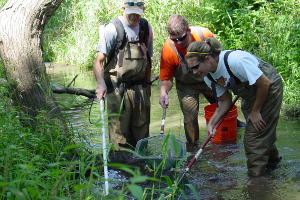Water Quality / Water Chemistry
Nearly all water quality evaluations rely on water chemistry analyses and the determination of the concentrations of various chemical compounds or substances. Water chemistry naturally varies regionally and seasonally in Iowa and elsewhere. The chemical content of water can also vary dramatically as a result of point source inputs (municipal and industrial waste treatment effluents) and non-point source inputs (agricultural and urban run-off, tile flow). The Limnology Section participates in several projects in which chemical analyses are the primary means of water quality assessment.
Ambient Monitoring
Limnology Section staff conduct the sampling for the Iowa Department of Natural Resources' (IDNR) ambient monitoring program, which evaluates long-term water quality trends in Iowa rivers and streams. The current program consists of nearly 100 sites sampled on a monthly basis. Field analyses (temperature, dissolved oxygen, pH, and stream flow) are completed on-site. Water samples returned to the laboratory are analyzed for nutrients, metals, pesticides, bacteria, other contaminants, and general water quality parameters such as conductivity, turbidity, and hardness.

Lake Monitoring
As with the ambient monitoring program for streams, the IDNR strives to characterize current water quality in Iowa's recreational lakes and identify trends in lake quality through time. Sampling has been conducted by Iowa State University Limnology and SHL's Limnology Section. Each year about 135 lakes are sampled three times for upto 30 parameters including nutrients, suspended solids, chlorophyll, phytoplankton and zooplankton. Sampling also includes lake profiles (taking measurements at intervals from the surface to the bottom) for temperature, dissolved oxygen, pH, turbidity, and dissolved solids. Lake sediments have also been analyzed for metals and selected pesticides and nutrients.
Cyanobacteria (blue green algae) occur in most freshwaters but high concentrations may be detrimental to human and animal health. Under certain conditions some cyanobacteria produce toxins such as microcystin which have been associated with symptoms including skin rashes, vomiting, and diarrhea. The lake monitoring program evaluates cyanobacteria levels and concentrations of cyanotoxins in Iowa lakes. Both of these services are available to individuals or organizations wishing to test private lakes or ponds. Contact us for more information.
TMDL Sampling

The Total Maximum Daily Load (TMDL) process is used to address impaired waters (placed on Iowa's 303d list). Sources of impairment are identified and eventually actions can be determined which will bring the waterbody back into compliance with state water quality standards. Under direction of the IDNR, Limnology staff conduct intensive assessment surveys which are designed to identify the nature of the impairment. The surveys involve routine water sampling on both streams and lakes and often include biological and event sampling. Loading from precipitation (run-off) events is often a major component of a given contaminant load but is difficult to quantify through routine water sampling. Automated samplers set-up on streams or tributaries to lakes can be activated remotely, when the stream reaches a pre-set level, or if the stream exceeds a given rate of rise.
Wastewater Sampling

Federal law requires facilities that discharge wastes into a waterway to obtain a National Pollutant Discharge Elimination System (NPDES) permit which specifies the type and amount of substances released. Permits often identify maximum or average concentrations that cannot be exceeded and/or specify the total amount of a substance (load) that can be released over a given period. Concentration and load criteria are typically based on a 24-hour period, necessitating the use of automated mechanical samplers. At the request of environmental enforcement agencies (usually IDNR) Limnology Section staff, conduct effluent monitoring to determine if permit criteria are being met. Automated samplers are typically set up at various locations in a wastewater treatment facility to evaluate the effectiveness of the treatment process.
Many homes in rural Iowa are not connected to municipal sewers and have their own treatment systems, which typically consists of a septic tank and leach field. Water leaving the tank disperses through the leach field where it slowly trickles into the soil. The soils in some areas of the state are not appropriate for leach fields and alternative methods of treatment are required. Mechanical treatment, sand filters, mound systems and wetland systems are examples of alternative methods. Contrary to leach fields, these alternative methods often have discrete effluent that is discharged onto the ground or directly into surface water. The Limnology Section has been involved in the study of the effectiveness of home treatment systems and you can contact us for additional information on services that may be available to you for a fee.
Whole Effluent Toxicity Testing

Whole effluent toxicity testing (WETT) has become an important method for assessing the impact of wastewater discharges. The implementation of rules adopted by the IDNR in 1991 requiring all major municipal and industrial dischargers to conduct annual whole effluent toxicity testing has resulted in continued expansion of the WETT program in the SHL Limnology Section. The number of tests performed has increased from 40 in 1991 to about 180 in recent years. The test uses fathead minnows (Pimephales promelas) and water fleas (Ceriodaphnia dubia) in a 48-hour static acute test. Basically, the test organisms are placed in beakers of whole effluent and diluted effluent and the mortality over the two-day test is determined. The dilution rates specified in each facility NPDES permit are based on the amount of effluent discharged and the size of the receiving stream.
Beach Sampling

Since 2002, Limnology Section or IDNR (currently conducting the sampling) staff have collected water samples at 35 state owned beaches which are analyzed for fecal bacteria. These bacteria are generally not harmful themselves but are indicator organisms. High levels of fecal bacteria indicate the water has come in contact with fecal material and that disease-causing microorganisms may be present. Results of the fecal bacterial analyses are used for management/policy decisions including potential beach closures.



